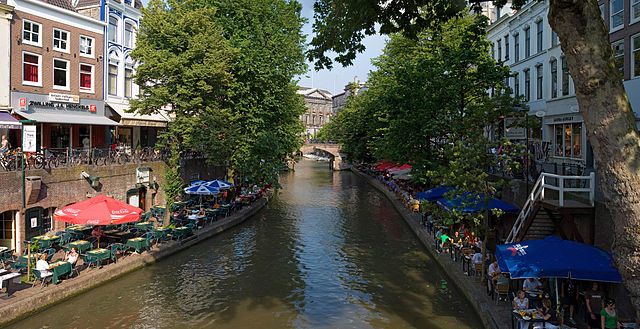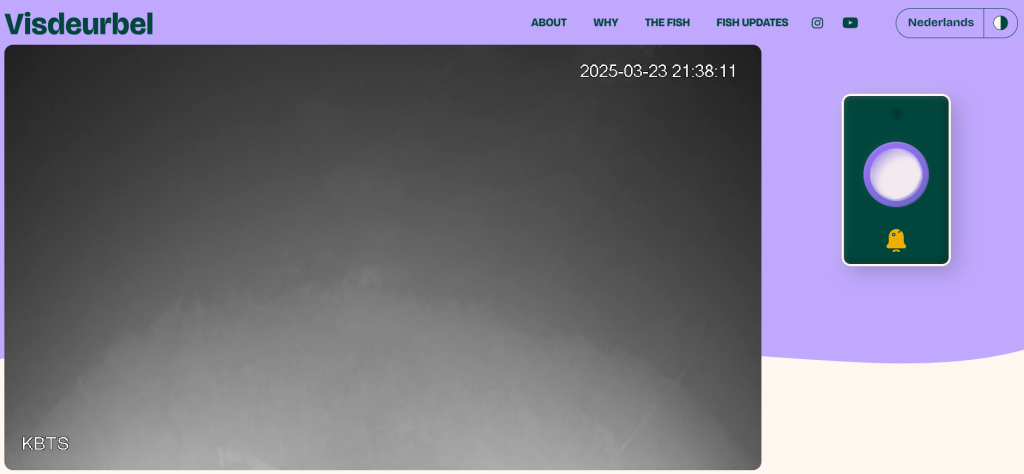Ring The Bell For Fish
The Dutch city of Utrecht is the fourth largest in the Netherlands by population, with about 375,000 people living there. It’s also home to a lot of canals, like the Oudegracht (or “Old Canal”), seen above. These waterways run through the city, but in many places have uneven depths. To prevent flooding and to help boats navigate their way through, the city outfitted the canals with locks — basically, boat elevators — in the late 13th century. (If you want to better understand how locks work, Wikipedia has a good explanation, with visuals, here.) Many of the locks are manually operated — when the lock attendant sees a boat coming (or a storm on the horizon), they turn a big wheel, shifting the flow of water, and allowing the boats to cruise on through. It’s a really good, and by modern standards, low-tech way to ensure that shipping lanes stay accessible.
But unfortunately, it’s not so great for fish.
The canals of Utrecht, including the Oudegracht, are used by certain species of fish as a conduit to their spawning grounds, and these fish typically use the Oudegracht in late March and April. Unfortunately, the canal isn’t used by boats very often that time of year, so the locks rarely open. This prevents the water from flowing, and therefore, the fish get stuck. As ecologist Mark van Heukelum explained to the Good News Network, “You have to see the Oudegracht (the canal) as a motorway for fishing. Sometimes you see literally dozens of fish floundering in front of the lock gate, so a fish jam is created.” And that’s a fatal problem for a lot of these fish, as it gives predators — typically, bigger fish — an opportunity to feast that they otherwise wouldn’t have.
So in 2021, van Heukelum came up with a solution: the Visdeurbel — literally, a “fish doorbell.” As Slate explains, “van Heukelum, who works as an environmental consultant, thought it would take a lot of effort and bureaucracy to implement a way for the fish to get through. But the lock operator offered a simpler solution. ‘He listened to me and said, ‘Well I can also open the lock right now for the fish.’ In fact, the lock operator was willing to open the lock more often, as long as he knew fish were present. Within a year, van Heukelum and his team had installed a camera, livestreaming the ecosystem below the water so that the public could monitor—and aid—the marine creatures.” Here’s the webcam and doorbell from yesterday, when I and 1,415 other people were eagerly waiting for a fish to swim by. (Sadly, my screenshot shows no fish; you can try your luck here.) The doorbell is situated to the right of the livestream of the stream.
More often than not, there are no fish to see on camera — as the AP reported, “Much of the time, the screen is just a murky green with occasional bubbles, but sometimes a fish swims past.” But when the fish appear, there’s almost always someone around the ring the bell. Per Slate, “in the first two weeks that the doorbell was deployed, it was pressed 32,000 times.” And now, four years later, there are regularly 1,000 or more people with the fishcam on and the doorbell at the ready.
The doorbell doesn’t open the lock automatically — so don’t worry about false alarms, internet trolls, or whatever the fish equivalent of ding-dong-ditchers are. Rather, it sends a screenshot to the people running the project. If there are enough fish gathering at the gate, the organizers let the lock operator know, who in turn spins the wheel, opening the lock.
The fish doorbell doesn’t operate year-round — the fish it serves migrate starting in the spring, so it opens in early March of each year. (This year, the camera went live on March 3, per the official website.) So if you want to help, now’s the time. And if you don’t see any fish during your shift, don’t worry — the organizers post weekly updates on their YouTube channel.
Bonus fact: Fish tanks are typically stationary — you don’t need to move them to get the full aquarium experience. But in 2021, a team of neuroscientists at Ben Gurion University of the Negev put that to the test, trying to teach a goldfish how to steer a motorized fishtank around obstacles on land. It worked. As Smithsonian reported, “the goldfish needed to learn how to drive the FOV [fish-operated vehicle]. Six adventurous goldish were enrolled in ‘driving school’ to learn how to move the FOV before the team collected the data. In 30-minute sessions conducted every two days, the fish were rewarded if they successfully directed the car to a pink-colored target in an enclosed space.” And to ensure they weren’t just memorizing a series of movements, “the team changed the FOV’s starting position and added decoy targets in different colors.” Over time, the fish became better and better drivers — but don’t expect them behind the wheel of an Uber any time soon. They’re still fish.
From the Archives: What Fish Can Teach Us About Voting: Do fish vote for their own best interest, or do they just follow the leader?


